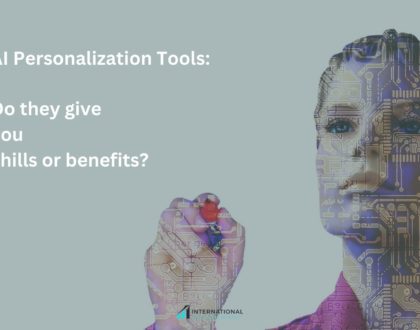The Future of B2B Sales: How AI is Changing the Game for Manufacturing Companies

Imagine this:
You’re a sales manager at a manufacturing company. You’ve got a team of dedicated reps, but the sales cycle is long, complex, and frankly, a bit of a slog. Leads are scattered, data is siloed, and predicting who’s actually ready to buy feels like trying to read tea leaves.
Sound familiar?
Well, you’re not alone. The world of B2B sales, especially in manufacturing, is undergoing a massive transformation.
And the catalyst? Artificial intelligence (AI).
Why AI in sales? And why now?
Let’s cut to the chase.
AI isn’t some futuristic fantasy anymore. It’s here, it’s real, and it’s revolutionizing how we sell. The sheer volume of data we generate today is overwhelming.
Trying to sift through it to find actionable insights manually is like searching for a needle in a haystack. That’s where AI shines.
Think of AI as your super-powered assistant. It can analyze vast datasets, identify patterns, and provide you with insights you’d never find on your own.
For manufacturing, this translates to:
- Predictive Analytics: Knowing which leads are most likely to convert before they even know they’re ready.
- Personalized Outreach: Tailoring your messaging to each prospect’s specific needs and pain points.
- Automated Tasks: Freeing up your sales team to focus on what they do best – building relationships and closing deals.
And why now?
Because the technology is mature, affordable, and readily available. Plus, your competitors are likely already exploring these solutions.
According to a recent report, companies using AI for sales see a 50% increase in leads and a 30% reduction in sales costs. And waiting means falling behind.
5 key benefits for manufacturing sales teams
Okay, so AI sounds great in theory, but what does it actually mean for your sales team?
Here’s a breakdown of the tangible benefits:
- Shorter Sales Cycles: AI can identify high-potential leads and prioritize them, allowing your team to focus on the most promising opportunities.
- Increased Win Rates: By providing personalized insights and recommendations, AI helps your team close more deals. Studies indicate that AI-powered sales tools can boost win rates by up to 25%.
- Improved Lead Qualification: AI can score leads based on their behavior and demographics, ensuring your team is focusing on the right prospects.
- Enhanced Customer Relationships: AI-powered tools can track customer interactions and provide valuable insights, enabling your team to build stronger relationships.
- Data-Driven Decision Making: AI provides accurate and actionable insights, empowering your team to make informed decisions.
How AI-Powered sales acceleration improves efficiency and revenue
Let’s dive deeper into how AI accelerates sales and boosts revenue in manufacturing.
- Automated Lead Generation: AI can scour the web for potential leads, identify relevant contacts, and even generate personalized email templates. This saves your team countless hours of manual research.
- Predictive Sales Forecasting: AI can analyze historical data and market trends to provide accurate sales forecasts. This allows you to plan your resources and strategies more effectively.
- Chatbots and Virtual Assistants: AI-powered chatbots can answer customer questions, provide product information, and even qualify leads. This frees up your sales team to focus on more complex tasks.
- Content Personalization: AI can analyze customer behavior and preferences to deliver personalized content, such as product recommendations or case studies.
- Sales Process Optimization: AI can identify bottlenecks in your sales process and suggest improvements. This can lead to increased efficiency and higher conversion rates. According to McKinsey, AI can potentially increase B2B sales revenue by 10%.
Let’s compare: With and without AI
Let’s paint a picture of how different sales processes look with and without AI.
Without AI:
- Sales reps spend hours manually researching leads, often relying on outdated or incomplete information.
- Outreach is generic, with little personalization, leading to low response rates.
- Lead qualification is based on gut feeling, resulting in wasted time on unqualified prospects.
- Sales forecasting is based on historical data and guesswork, leading to inaccurate predictions.
- Data analysis is time-consuming and often yields limited insights.
With AI:
- AI automatically identifies and prioritizes high-potential leads, saving sales reps valuable time.
- AI-powered tools provide personalized insights, enabling targeted outreach and higher response rates.
- AI scores are based on their behavior and demographics, ensuring sales reps focus on qualified prospects.
- AI analyzes historical data and market trends to provide accurate sales forecasts.
- AI provides real-time insights, enabling data-driven decision-making and process optimization.
It’s time to take action and embrace the AI revolution
Look, I get it. Change can be daunting. But the reality is, AI is no longer optional for manufacturing sales. It’s essential. The companies that embrace AI will be the ones that thrive in the years to come.
Here’s how to get started:
Step #1: Assess your current sales process
- Identify areas where AI can make the biggest impact.
- Go beyond surface-level observations. Conduct a thorough audit of your entire sales funnel. Map out each stage, from lead generation to closing, and identify pain points. Where are the bottlenecks? Where are deals getting stuck?
- Analyze your data. Look at your CRM reports, sales metrics, and customer feedback. Where are you losing leads? Where are your win rates low? Where are customers expressing frustration?
- Involve your sales team. They’re on the front lines and have valuable insights into the challenges they face. Conduct interviews and surveys to gather their perspectives.
- Consider specific manufacturing challenges. Complex product configurations, long lead times, and highly technical sales processes can all benefit from AI-driven automation and optimization.
Example: If your team spends too much time researching potential clients, that is an area where an AI-powered lead generation tool could be very effective.
Step #2: Research AI solutions
- There are a plethora of AI-powered sales tools available. Find the ones that best fit your needs and budget.
- Don’t get overwhelmed by the sheer number of options. Start by defining your specific needs and priorities.
- Look for solutions that integrate seamlessly with your existing CRM and other sales tools. Integration is crucial for maximizing data flow and efficiency.
- Consider solutions that offer industry-specific features. Manufacturing has unique needs, so look for tools that are tailored to your sector.
- Read reviews and case studies. Get insights from other manufacturers who have implemented AI solutions.
Example: If you need to improve your sales forecasting, researching AI powered predictive analytics, would be a good place to start.
Step #3: Pilot a small project
- Start with a pilot project to test the waters and see how AI can benefit your team.
- Choose a specific area of your sales process to focus on. Don’t try to implement AI across the board at once.
- Select a small, representative group of sales reps to participate in the pilot project.
- Set clear goals and metrics for the pilot project. What do you want to achieve? How will you measure success?
- Monitor the pilot project closely and gather feedback from the sales reps involved.
Example: A pilot program for an AI powered chatbot on the company website, to respond to customer inquiries.
Step #4: Scale up gradually
- Once you’ve seen positive results, gradually scale up your AI implementation.
- Don’t rush the process. Take your time and ensure that your sales team is comfortable with the new tools and processes.
- Provide ongoing training and support to your sales team. AI is constantly evolving, so continuous learning is essential.
- Expand the use of AI to other areas of your sales process, based on the success of the pilot project.
Example: After a successful chatbot pilot, expand the use of the chatbot to handle more complex customer interactions.
Step #5: Continuously optimize
- AI is an ongoing process. Continuously monitor your results and make adjustments as needed.
- AI is not a “set it and forget it” solution. You need to continuously monitor its performance and make adjustments as needed.
- Track your key metrics and identify areas for improvement.
- Stay up-to-date on the latest AI trends and technologies.
- Seek feedback from your sales team and customers.
Example: Regular analysis of the AI powered lead scoring system, to ensure it continues to identify high potential leads.
By following these steps, manufacturing companies can effectively integrate AI into their sales processes and reap the benefits of increased efficiency, revenue, and customer satisfaction.
Bonus tips and tricks
- Start small: Don’t try to implement every AI solution at once. Begin with a specific area, like lead scoring or sales forecasting.
- Focus on data quality: AI is only as good as the data it’s fed. Ensure your data is clean, accurate, and up-to-date.
- Invest in training: Your sales team needs to understand how to use AI tools effectively. Provide them with the necessary training and support.
- Integrate your CRM: Ensure that your AI tools are fully integrated with your CRM to maximize data flow and efficiency.
- Personalization is key: Use the data that AI provides to personalize every aspect of the sales process.
To wrap up
The future of B2B sales is here, and it’s powered by AI. So, are you ready to embrace the revolution and transform your manufacturing sales team?
What steps will you take today to integrate AI into your sales process? It’s up to YOU!
Recommended Posts

Lead generation in the AI era
May 16, 2023

AI Personalization Tools: Do they give you chills or benefits?
December 19, 2022



